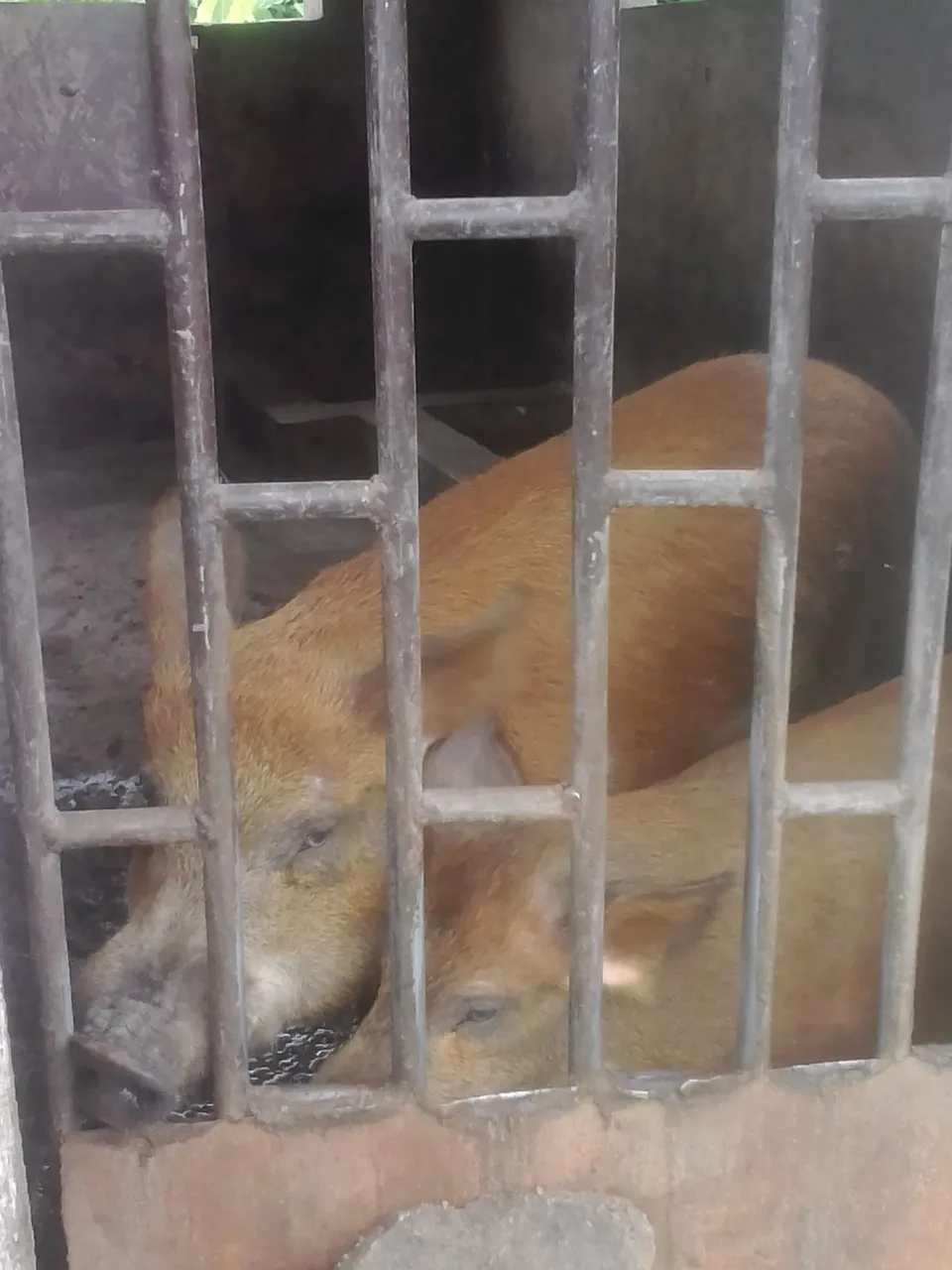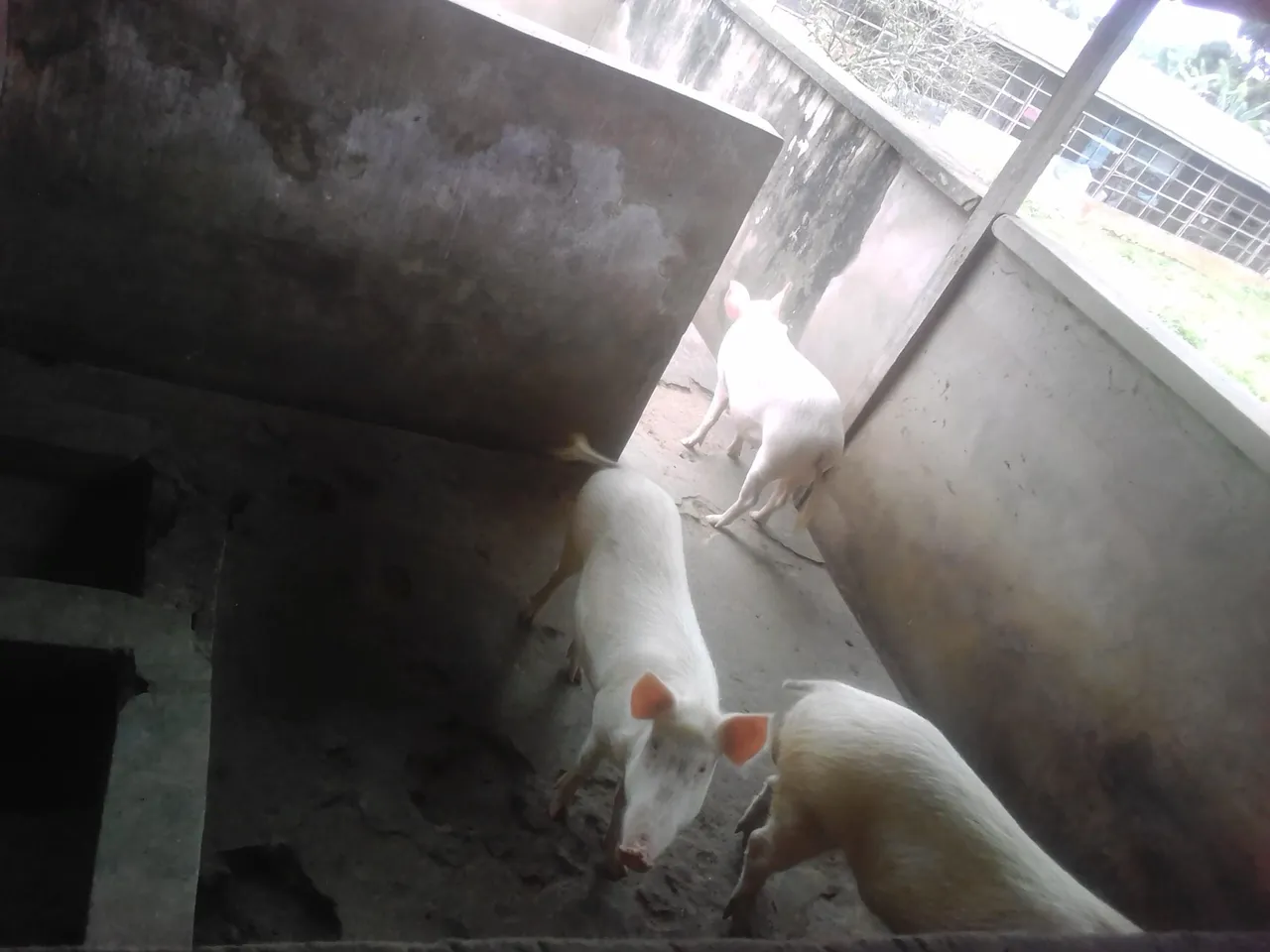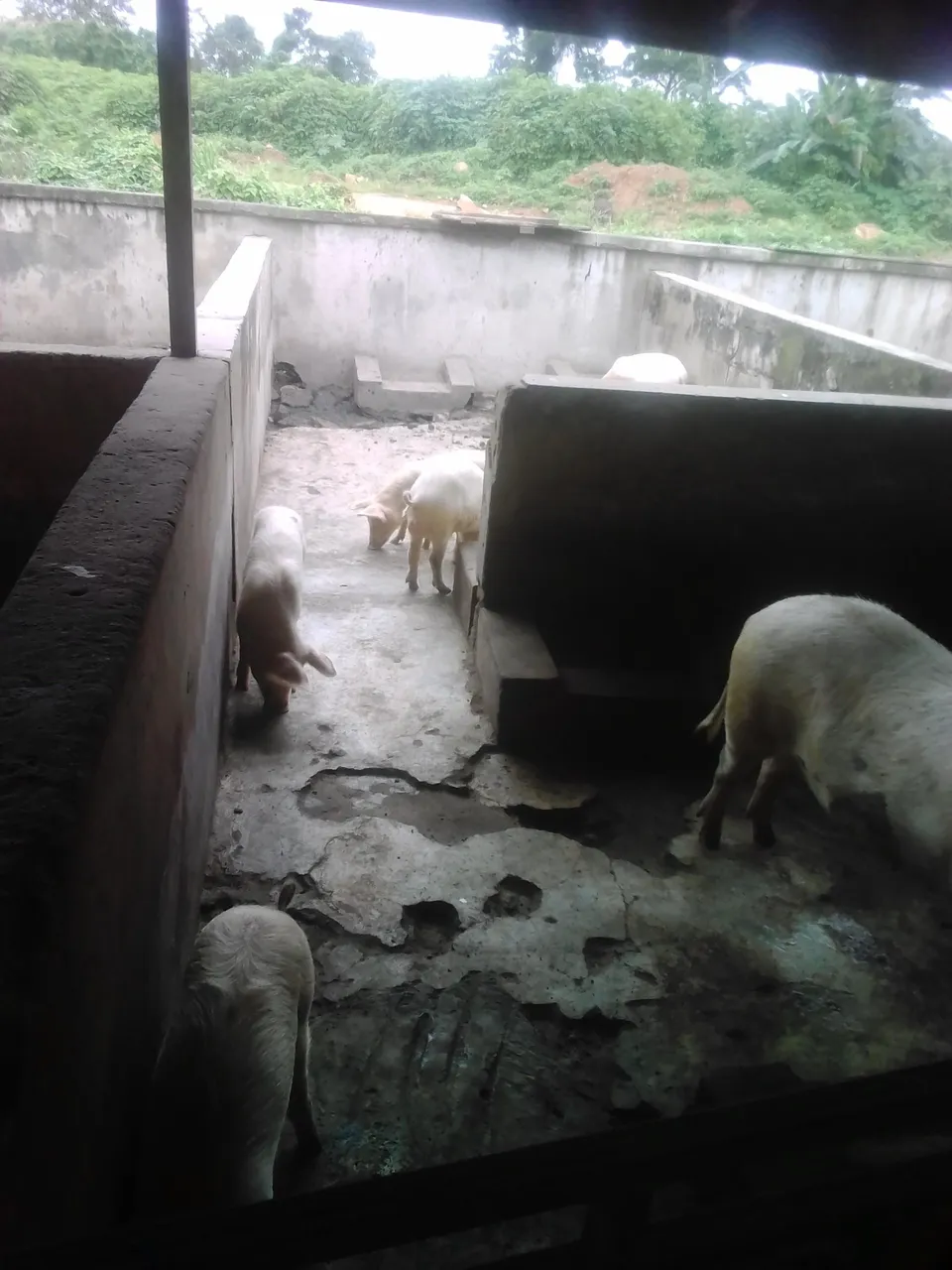
GUIDING QUESTIONS
*CARE AND MANAGEMENT PRACTICES OF PIGS THAT IS PREGNANT.
*SAFETY PRECAUTION ON HOW TO TREAT PIGS AFTER FARROWING.
*APPROPRIATE TECHNOLOGY USED FOR PIGS WHEN FARROWING.
*HOW APPROPRIATE TEVCHNOLOGY HAS HELPED IN CURING DISEASE OF PIG DURING PREGNANCY.
*CONCLUSION ON HOW APPROPRIATE TECHNOLOGY HAS HELPED IN REPRODUCTION OF PIGS.

INTRODUCTION
Pig, hog and swine are all genetic terms without regard to gender, size or breed originated from Eurasian wild boars. A typical pig has large head with a long snout which is strengthened by a special pre nasal bone and a disk of cartilage at the tip ,there are four hoofed toes on each foot with the two larger central toes bearing most of the weight. A single pig gives birth to as much as fifteen (15) piglets at a time making it one of the most reproducing livestock in the world. Baby pigs are known as shoat or piglets. Piggery is defined as a farm where pigs are breed or kept (Oxford Dictionary). Reproduction can be defined as the process by which plants and animals give rise to offspring (Merriam-Webster).
Federal university of technology pig farm can be found besides the FUTA Scoops building along Jadesola hostel via malu road, Ondo State in Akure .It has different kinds of building structures which is surrounded with pawpaw trees. This paper focuses on the reproductive aspects of pigs.
2.0 LITERATURE REVIEW
2.1 PRE WEANING PERIOD
Exudative dermatitis (greasy pig) the symptoms of this disease are skin lesions, caused by an infection of the bacteria Staphylococcus hyicus. In severe cases, mortality can occur, as the bacteria damage the liver and kidneys. Lesions first present as dark areas of skin, which spread and become flaky with a greasy feel. Antibiotics are used to treat the infection, along with skin Protestants; autogenously vaccines have also been used with success. Improving hygiene in piglet housing is the key to preventing this condition, along with teat dipping of sows pre- and post- farrowing. It is also important to reduce the potential for skin abrasions, as this is how the infection enters the body. Abrasions are caused by rough floors, jagged teeth, sharp equipment or even mange mite’s bites.
2.2 COCCIDIOSIS
This disease is very common in suckling piglets and is caused by three types of the intracellular parasite coccidian. It causes diarrhea, which can be bloody, often between 10 and 21 days of age and up to 15 weeks of age. Acute cases are treated with fluid therapy and coccidiostats. Secondary infections can result from damage to the intestinal wall. Depending on the level of occurrence on the farm, preventative treatment of sows with coccidiostats may be appropriate. Hygiene should be improved to end the cycle of infection; sow feces are a major source, and flies can spread infection. Providing a warm, dry, clean creep area will help to reduce the parasite load and the likelihood of coccidian infection.
2.3 POST WEANING-PROCESS
Respiratory diseases coughing, sneezing, abdominal breathing, reduced growth rates and potentially mortality are all signs of respiratory disease. Depending on the cause, antibiotics may be given in feed, water or as an inject able. Poor ventilation or environmental conditions can exacerbate respiratory conditions. For example, high levels of ammonia can damage the respiratory tract, making pigs more susceptible to infection. Infective agents include Streptococcus Suis and Pasteurella vaccines are available for some forms of pneumonia, although the strain affecting a farm should be identified to ensure a successful outcome..
2.4 SWINE DYSENTRY
Animals with this disease suffer from diarrhea, with or without the presence of blood. It is caused by the bacteria Brachyspira hyodsenteriae. Growth rates of post-weaning pigs are reduced, and, in some cases, sudden death can occur. Antibiotics are used to treat the disease, either in feed, water or as an inject able. Reducing stocking density can be an effective way of reducing infection pressure and stress in the herd. As well as improving hygiene levels, rodent control is a high priority; rodents are a vector for this disease.
2.5 BREEDING STOCK
Reduced milk production, loss of appetite and a higher body temperature are symptoms of mastitis in sows. It is caused by a bacterial infection of the mammary glands, where skin discoloration can be seen. Antibiotics, along with anti-inflammatory drugs are effective treatments. Oxytocin may be used to encourage let down of milk and corticosteroids can be prescribed. Hygiene in farrowing housing is important, along with nutrition during late pregnancy to promote immunity. Stress can also be a factor, and it is important to make sure that teats are not being damaged by sow housing facilities. This disease has a significant effect on productivity because of the potential effect of reducing the number of piglets weaned by sows.
2.6 PORCINE PARVOVIRUS
If pregnant sows become infected with parvovirus (PPV), reproductive disease can occur, but not in all cases. If it does, most commonly in gilts, reproductive performance is significantly affected. Mummification and stillbirths occur, resulting in small litter sizes. Other reproductive diseases have the same symptoms so accurate diagnosis is essential. Unusually, the virus can survive outside the host for several months, making it endemic in most herds. Although it is only during pregnancy that PPV is a problem, other pigs can spread the virus. There are no treatments available; in order to prevent this disease routine vaccination of gilts is advisable.
3.0 FARROWING
3.1 CARE AND MANAGEMENT
Care during pregnancy and Farrowing
After breeding, the sow should be kept in dry clean and hygienic enclosure in comfortable place. It should be closely observed for estrus symptoms around 20 days after breeding to assure the non - return of estrus and expect the conception. Pregnant sow should be shifted to a clean house before 3 weeks of farrowing. Clean and dry bedding material preferably of dry paddy straw/hay has to be provided in the pen. The pregnant animal should be fed individually
Breeding management
Indigenous pigs normally reared by farmers are bred indiscriminately without much choice of male. Moreover, during the process of scavenging, there is no control over breeding. Reproduction is the main component limiting the productive efficiency of pig industry. Successful reproduction is the outcome of a series of closely linked events. The gilt must grow rapidly to attain sexual maturity, initiate estrous cycle, ovulate and be mated by a fertile boar or inseminated with fertile semen. The female pig becomes sexually mature between 8 - 10 months depending on the breed and nutrition level. But the local pig attains maturity at 5 - 6 months. The length of the estrous cycle averages approximately 21days (18 - 24 days.
3.2 PIG PRODUCTION CYCLE
The pig is the only large farm animal that has a large number of offspring. During each estrus cycle more then 15-20 eggs are usually ovulated. In sheep the situation is in the middle, some sheep breeds have only one or two lamb, others 4 or 6. The basic mechanism of the estrus cycle in pigs is very similar to other farm species. However, there are some differences that are important to know for good management of reproduction.
3.3 FEEDING SYSTEM
(1)Liquid feeding for consistency
This support a gradual transition liquid feeding, as this system delivers liquid to porridge-like feed with a consistency which is optimal for the nutritional requirements of piglets. In this context, special sensor controlled liquid feeding systems are becoming more and more important. In such systems, individual feed portions are transported to the trough by means of compressed air which also ensures that the feed pipes are left completely empty after feeding this is as result of appropriate technology in piggery.
(2)Block feeding
Weigh of approximately 16 kg; the piglets enter a phase where they must share the feeding area with other piglets. For the piglets this means ranking fights and therefore an increased level of stress. As soon as the social structure has been developed the order for feed intake is set according to rank. The higher-ranking piglets eat first and the lower-ranking ones afterwards. The hygiene status in the entire rearing house – particularly the feed and water supply – is of the highest importance. Exposure to germs of any kind must be absolutely avoided and monitored at regular intervals! The entire feed supply chain, from the storage of the raw components to the preparation of the feed mixture, from the transport routes to the feeding area, must be closely observed.
4.0 FIELD WORK OF RESEARCH
4.1DEFINITION OF REPRODUCTION
Reproduction (or procreation or breeding) is the biological process by which new individual organisms – "offspring" – are produced from their "parents". Reproduction is a fundamental feature of all known life; each individual organism exists as the result of reproduction. There are two forms of reproduction: asexual and sexual. Sexual reproduction typically requires the sexual interaction of two specialized organisms, called gametes, which contain half the number of chromosomes of normal cells and are created by meiosis, with typically a male fertilizing a female of the same species to create a fertilized zygote.
4.2 AIM OF STUDY
The paper focuses on the reproductive aspect of piggery, the disease, challenges and care given to pigs during farrowing. It also discussed appropriate technology used during pregnancy period (farrowing).
4.3 DEFINITION OF HEAT PERIOD
Heat period is also called Estrous cycle and this term is used for animal females. It defines the time, when such females are open for mating and can conceive. However, the term is not used for women. Their sexual desire has no strict pattern in relation to the menstrual cycle. It does not depend solely on their physique, but instead it is affected by a range of factors: sociological, emotional, etc
4.4 CHALLENGES FACED BY PIG FARMER
The challenges can be in the following forms
(1)Foreign animal disease
(2)Scarcity of pigs during the past festive season
(3)Environmental impact is one of the problems in pig farming because pollution from animal production can arise from a number of different sources such as the excretion of excess dietary nitrogen by the animal and release of atmospheric ammonia and inappropriate housing conditions which give rise to obnoxious odors and gases
5.0 CONCLUSION
This paper investigated the use of appropriate technology in piggery system and how it has been helping in fighting the diseases of the pigs and the kind of diseases that pigs can be infected with within the period of giving birth at federal university of technology Akure. This paper has shed more light on how such disease can be tackled or controlled; it has brought understanding on how appropriate technology has affected the reproduction of pigs.
5.1 RECOMMENDATION
In the light of the study carried out on appropriate technology in piggery (reproduction), the following recommendations are presented
(1) Farmers should be conscious about pig’s health, in areas like medical attention, feeding e.t.c.
(2) Farmers should call veterinary doctors to treat the pigs, without proper treatment pigs can be dehydrated and this can lead to death.

6.0 REFRENCES
Saliu, A. (2003). Essential Agricultural Science: Mac printing press.
Dam, F. (2010). Opportunities and management practice of pig production: Marcos Regional state press, Ethiopia.
C.S.A (Central statistical authority) (2010). Pig reproduction and Management: Addis adaba, Ethiopia.
Bimrew, A. (2014) Livestock development Master plan study: Report Data Collection and Analysis.
Schoe, F. (2007) Assessment of pig production and constraints: Mecha district, Amarah region publications.
Tischendorf, F. & Kirchmein, U. & Juries, G. (2002) Quality in developing pigs: New Jersey press
https://www.google.com/url?sa=t&rct=j&q=&esrc=s&source=web&cd=2&cad=rja&uact=8&ved=0ahUKEwji2q_O5rzXAhVKY1AKHa8WDy8QFghVMAE&url=https%3A%2F%2Fen.wikipedia.org%2Fwiki%2FReproduction&usg=AOvVaw0bRiTkL6ayl4YyryRbOscf
https://www.google.com/url?sa=t&rct=j&q=&esrc=s&source=web&cd=3&cad=rja&uact=8&ved=0ahUKEwji2q_O5rzXAhVKY1AKHa8WDy8QFghhMAI&url=http%3A%2F%2Fjohnfriedmann.com%2Fbiogloss%2FReproduction-whatis.htm&usg=AOvVaw1YkZmZcdLURftKBqrahE6I
